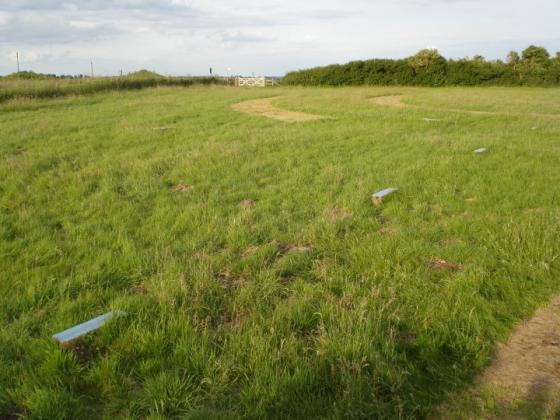Details of Long Barrow on Pastscape
(SU 09437221) Shelving Stone (NAT) Long Barrow (NR) (site of) The name Shelving Stone (see SU 17 SW 41) has been incorrectly associated with the site of a long barrow – Winterbourne Monkton 17 a (2), known as Millbarrow or King’s Mill Barrow (3). Andrews & Dury (4) show and describe the barrow, where, at the present day, there is a large stone in the hedge (3). It was illustrated by Stukeley (5) and shown on OS 2” Drawing (6) annotated “Tumulus”. (The error appears to have originated in the linking by Crawford (7) of the site of a cromlech in ‘Monkton fields’ (8) known by Aubrey as ‘Shelving Stone’ with the long barrow shown on the 2” Drawing (6)).
Millbarrow was apparently 215ft long (3) by 55ft wide (8) and set round with a peristalith or orthostatic revetment of megaliths, orientated east to west.
A farmer levelled the barrow sometime prior to 1858 (8) but only discovered a few human and animal teeth and a jaw-bone. Thurnam (a) dug on the site in 1863 with negative results.
The megalith, on which is cut BM 544.4 (7) (SU 09437219-OS 6” 2nd Edt 1900) which survives in the hedge adjoining the barrow may be the remains of the Millbarrow chamber or revetment (3). According to Smith (10) the site retains several other stones as well as a portion of the chalk mound and traces of a side ditch. The remains conform to Stukeley’s drawing of Millbarrow.
There are no surveyable remains of the long barrow nor any trace of the large stone (3) and the ‘several other stones’ (10).
The hedges have been cleared and the area is under crop. Nothing visible on OS AP 73/071 240. Site described by Barker (12). Antler fragments were found in 1961 in throw-out from a burrow. The fragments are in the Keiller Museum, Avebury. The remnants of the mound were removed by the landowner in 1967, apparently unaware of the barrow’s presence.
The barrow was excavated in 1989 by Alasdair Whittle. Two ditches were found flanking each side of the barrow, the inner pair c. 18m apart. Finds from all four ditches were scarce. Part of the eastern end of the tomb was excavated, revealing features including a possible former chamber area, facade and kerb, plus post holes. Fragments of human bone and sherds of Peterborough ware were among the finds. In addition, some pits and post holes appear to pre-date the mound. Two of the pits contained human remains. (12-13, 16)
Radiocarbon dates from human bone and antler recovered in 1989 range from 4900 plus/minus 110bc to 4480 plus/minus 80bc, suggesting that construction occurred in the later 4th millennium BC. (14, 16)
Whittle’s use of antiquarian records to interpret excavated features of Millbarrow has been criticised by Ucko et al. (15)
The mound of the long barrow was seen on a 2006 lidar survey. The monument is respected by a neighbouring field system. (17)













































































































































